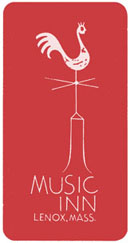
On a chaotic evening in July 1950, Philip and Stephanie Barber opened the doors of the renovated farm buildings they had named Music Inn. Alan Lomax, Rev. Gary Davis, Woody Guthrie and Pete Seeger were the first performers to play in this idyllic setting to a small audience of about fifty Inn guests. The first night, the country pipes ran out of water and the Barbers had to send their guests to their rooms with bottles of ginger ale to flush the toilets. Despite a series of such trials, these new innkeepers persevered and created a celebrated haven for musicians and music lovers alike.
The Barbers initially invited jazz and folk artists to perform for and entertain their other guests, and they invited Professor Marshall Stearns to talk about jazz and musical traditions. The lively give and take among the musicians, the audience, and Stearns led to formal discussions called “Roundtables” and later to a formalized “Jazz Workshop” exploring the roots and nuances of jazz, folk and blues. Musicians included Woody Guthrie, Pete Seeger, Eubie Blake, Candido, Tony Scott, Michael Olatunji, Brownie McGhee, Sonny Terry, Tom Glazer, John Lee Hooker, and Randy Weston. Poet Langston Hughes participated in the roundtables, read poetry, and introduced gospel singer Mahalia Jackson to the Barbers. A famed singer in the black church world, her performance at Music Inn marked her introduction to white audiences. Music Inn quickly gained a reputation in the jazz and folk communities as a unique place where musicians could bring their families and enjoy a relaxed environment, and where people were genuinely interested in their music and what they had to say about it.
The popularity of the “Roundtable” discussions and performances soared among musicians, as Music Inn gained a reputation as a relaxed, family-friendly environment, and as a center of serious musical exploration. To accommodate the larger audience clamoring to hear the music, in 1955 the Barbers created the Berkshire Music Barn, setting up 600 seats in the courtyard of the hay barn. The Berkshire Music Barn became the first venue of its kind devoted solely to the presentation of jazz and folk. Tapping contacts and connections gathered from the years of “Roundtables”, Stephanie was able to program summer concerts featuring the top artists of the day – people like Louis Armstrong and Ella Fitzgerald. (See Appendix for list of Performers).
A kind of magic was captured at Music Inn. Musicians who had never played anywhere but in dingy bars and loud, smoky clubs were given due attention and respect at last. As Stephanie Barber pointed out, "It was the first theater for jazz where people weren't drinking and talking – they were paying attention to the music."

